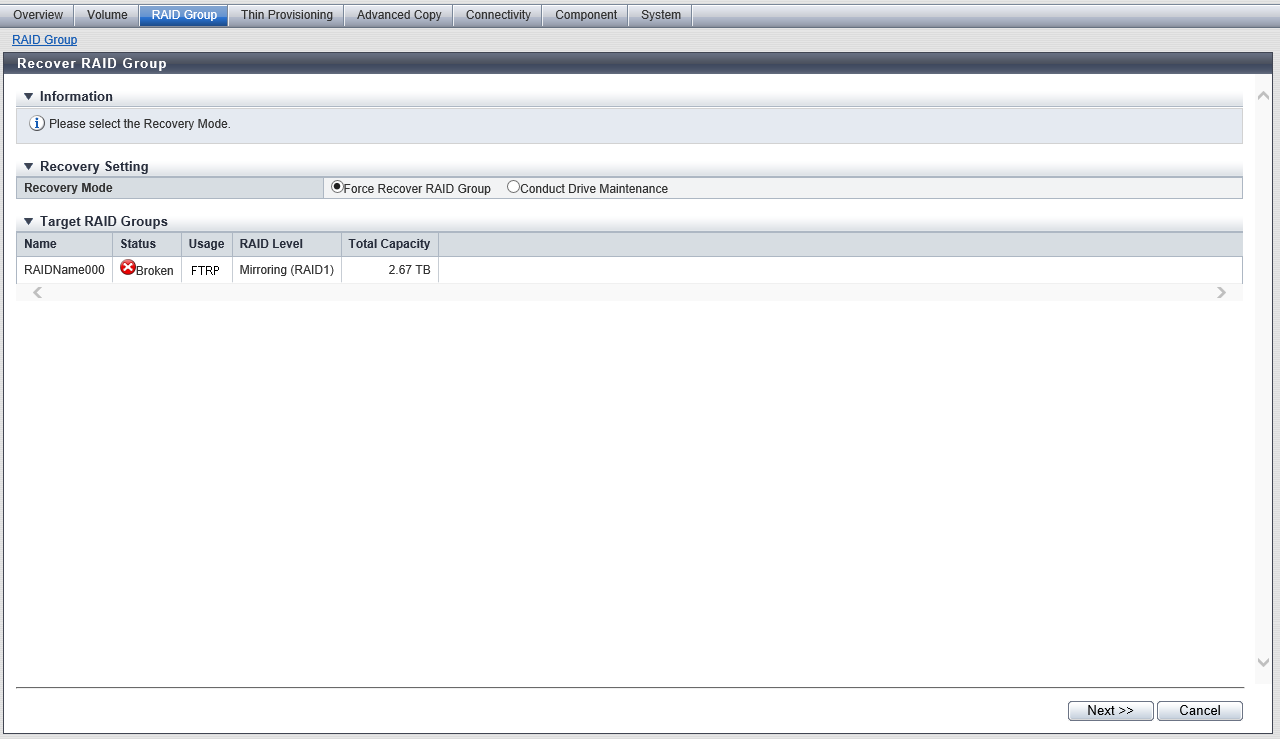Recover RAID Group
Overview
This function recovers the RAID groups that are in failed status.
There are two methods available for recovery:
Force Recover RAID Group
The RAID groups are forcibly recovered by changing the drive status.
Conduct Drive Maintenance
If forcible recovery of the RAID groups is not possible, perform the following operations to recover the RAID group:
Back up any data that can be recovered (if required)
Perform hot maintenance for any drives with the "Broken" state
Format all the volumes in the RAID group
Restore backed up data and recover the data
Requirements for Recovering a RAID Group
The RAID group status is "Broken"
A drive with the "Failed Usable" state exists in the RAID group
No error occurs for writing from the host to the "Failed Usable" drive
No error occurs for accessing all the drives in the RAID group
The RAID group is not blocked
If the forcibly recovery of a RAID group is interrupted, the RAID group is blocked. However, a forcible recovery of the RAID group can be performed again.
Follow the Support Department instructions when this function is required.
After a RAID group is recovered, perform hot maintenance for any drives with the "Broken" state.
User Privileges
Availability of Executions in the Default Role
| Default role | Availability of executions |
|---|---|
| Monitor | |
| Admin | |
| StorageAdmin | |
| AccountAdmin | |
| SecurityAdmin | |
| Maintainer |
Refer to "User Roles and Policies" for details on the policies and roles.
Settings
Select the RAID group recovering method.
Recovery Setting
| Item | Description | Setting values |
|---|---|---|
Recovery Mode |
Select the RAID group recovering method.
|
Force Recover RAID Group Conduct Drive Maintenance |
Display Contents
In this screen, the RAID groups that are selected in the [RAID Group] screen are displayed.

Target RAID Groups
| Item | Description |
|---|---|
|
Name |
The RAID group name is displayed. |
|
Status |
The RAID group status is displayed. Broken |
|
Usage |
The usage of the RAID group is displayed. Standard Standard / WSV WSV TPP FTRP RDB Temporary |
|
RAID Level |
The RAID level is displayed. High Performance (RAID1+0) High Capacity (RAID5) High Reliability (RAID6) High Reliability (RAID6-FR) Reliability (RAID5+0) Mirroring (RAID1) Striping (RAID0) |
|
Total Capacity |
The total capacity of the RAID groups is displayed. |
[Force Recover RAID Group] Screen
Drives can be checked from the list or the installation image. To switch between the list and the installation image, click the tab. Only the drives with the "Broken" state in the selected RAID group are displayed.
[Tabular] Tab
| Item | Description | |||
|---|---|---|---|---|
|
Enclosure |
The enclosure where the drive is installed is displayed. CE: Controller Enclosure (2.5" and 3.5") DE: Drive Enclosure (2.5", 3.5", and 3.5" high density DEs) CE CE#x DE#yy x: CE number yy: DE number |
|||
|
Slot No. |
The slot number of the enclosure where the drive is installed is displayed. 2.5" CE/DE: 0 - 23 3.5" CE/DE: 0 - 11 3.5" high density DE: 0 - 59 |
|||
|
Type |
The drive type displayed for this item is a combination of the following.
Note that "SED" is also displayed for self encrypting drives and "AF" is also displayed for Advanced Format compliant drives.
|
|||
|
Capacity |
The capacity of the drive is displayed. |
|||
|
Speed |
The drive speed is displayed. For SSD or SSD SED, a "-" (hyphen) is displayed. 15000 rpm 10000 rpm 7200 rpm |
[Graphic] Tab
| Item | Description |
|---|---|
|
(Drive display) |
For 2.5" CEs or 2.5" DEs, the slot numbers are applied from left to right in ascending order. For 3.5" CEs, 3.5" DEs, or 3.5" high density DEs, the slot numbers are applied from the bottom left to the top right in ascending order. Placing the mouse pointer on the icon displays the detailed information of the drive. |
Operating Procedures
When Selecting "Force Recover RAID Group"
Select the RAID group that is to be recovered and click [Recover RAID Group] in [Action].
Select "Force Recover RAID Group" for the recovery mode, and click the [Next >>] button.
→ Preparation for forcible recovery starts.
Perform the maintenance operation according to the procedure displayed in the [Force Recover RAID Group] Screen.
After completing maintenance for all of the drives, click the [Recover] button.
→ A confirmation screen appears.
Click the [OK] button.
→ Forcible recovery starts.
Click the [Done] button to return to the [RAID Group] screen.
When Selecting "Conduct Drive Maintenance"
Select the RAID group that is to be recovered and click [Recover RAID Group] in [Action].
Select "Conduct Drive Maintenance" for the recovery mode, and click the [Next >>] button.
Click the [Recover] button.
→ A confirmation screen appears.
Click the [OK] button.
→ Preparation for recovery starts.
Click the [Done] button to return to the [RAID Group] screen.
Perform hot maintenance of the drives.



